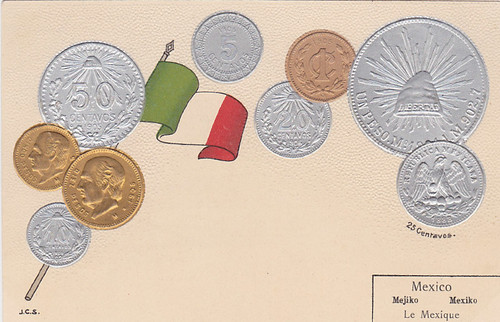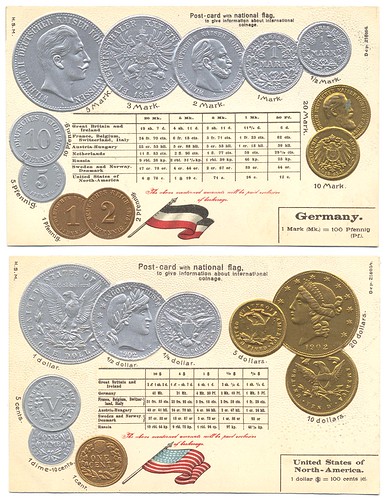
PREV ARTICLE
NEXT ARTICLE
FULL ISSUE
PREV FULL ISSUE
MORE ON NUMISMATIC POSTCARDSDavid Gladfelter writes: Don Kolkman’s postcard with embossed Mexican coins is a Hugo Semmler product, although it lacks Semmler’s name or initials as well as the exchange rate table. The card was probably printed for a jobber to distribute. No jobber’s name appears either, although Semmler is known to have produced cambist postcards for at least nine jobbers throughout the world located in Europe, South Africa and South America. I have the same card with a 6 March 1908 postmark, also an unpostmarked variant (different flag) with a jobber’s initials J.C.S. in the lower left corner (see illustration). A later card with the same Mexican face design has the imprint of Max Heimbrecht on the back. Heimbrecht was Semmler’s business successor circa 1912.

Semmler’s H.S.M. imprint appears on a card (see accompanying illustration) showing an earlier series of Mexican coins, the latest of which is dated 1904. When new coins came out the following year, Semmler changed the design.

Frank Draskovic writes: My thanks to our editor for confirming that my short submission about the H.S.M. set of Coin Postcards originally contained no reference to the Blumel album, the comments referring only to my own, ca. 1905, album. And of course the illustration of the “Fortuna” seller label would have left no doubt as to the original source of the postcard set. As to the publisher’s initials and my presumption of “H.S.M.” being for Hermann Sonntag of Munich, I found that attribution at an excellent and highly recommended website published by The Metropolitan Postcard Club of New York City, under their “Guide To Publisher’s Initials”, wherein they explain in part, “While some publishers used initials exclusively to identify themselves, others alternated between their full name or logo without any consistency. Due to the nature of initials there are multiple publishers who used the same letters so this method of identification is by no means foolproof. It may also be difficult to determine if the initials belong to a publisher or to a printer, as the same company could function as one or the other or both at the same time. It may be noted that on many European cards the abbreviation may incorporate the name of the publisher’s town so they don’t exactly match the company name. Many times the full written name of the town may follow the initials, which is often confused with part of a person's name. Most initials will appear on the back of a card but sometimes they might be found on the front. In this case it is important not to confuse them with the initials of the artist who might have illustrated the card.” One of Mr. Gladfelter’s illustrated German cards is clearly from publisher Hugo Semmler of Magdeburg, and it is more than likely that the H.S.M. shown on his second illustrated German card represents the same firm. I just now checked my set again (I’ve spent more time with these in the last two weeks than the previous quarter century!) and find that those with the “H.S.M.” logo, printed on the front on 40 of 46 cards, are all divided backs (DB) with a stamp box at upper right that contains “Printed in Bavaria”, i.e. Munich, whereas Magdeburg is in Saxony. But of course publisher Semmler in Magdeburg could have had some of his run made in Munich, Bavaria or maybe he moved his business. Interestingly only one postcard, from my album set of 46, shows a place of manufacture other than Bavaria. The Tunis card has, within the stamp box, “Printed at works in Saxony” (what fun!…kind of like mintmarks!), yet it is one of the above mentioned six without “H.S.M.” or other maker logo (Uh-oh, now we have die varieties too). Here is my German card, (different than both of Mr. Gladfelter’s and with a 1905 date on the Half-Mark that I previously missed) and also the ever popular USA card. Note that on all three German cards, the coin above the denomination “3 Mark”, is not a Three Mark coin at all, rather the reverse of a Vereinstaler (Union Taler) of 1867, perhaps the Prussian version of the Munzverein (coinage union) issues that began in 1857 and lasted until the advent of the German Empire in 1871, with its new Mark denomination coinage. After unification, the Vereinstalers circulated with a value of 3 Marks, and as these three postcards were produced prior to the issuance of 3 Mark denominated coins in 1908, the Vereinstaler shows with a value of 3 Mark. The latest coin date on the US card is 1902 seen on the half dollar and gold $20. Both say “Printed in Bavaria” within the reverse stamp box.

Kudos to cherry picker Don for finding the USA card. Perhaps others will also consider collecting these fascinating examples of numismatic ephemera!" To visit the Metropolitan Postcard Club of New York site, see: www.metropostcard.com To read the Club's Guide, see: Guide to Publisher’s Initials (www.metropostcard.com/guideinitials.html)
To read the earlier E-Sylum article, see:
MORE ON NUMISMATIC POSTCARDS AND ALBUMS
(www.coinbooks.org/esylum_v17n03a12.html)
The Numismatic Bibliomania Society is a non-profit organization promoting numismatic literature. See our web site at coinbooks.org. To submit items for publication in The E-Sylum, write to the Editor at this address: whomren@gmail.com To subscribe go to: https://my.binhost.com/lists/listinfo/esylum All Rights Reserved. NBS Home Page Contact the NBS webmaster 
|